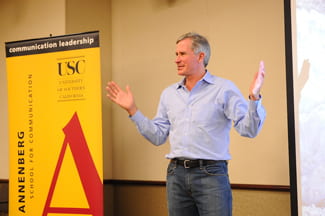 Few things come as a surprise to experienced climbers, who must constantly be ready for treacherous terrain or life-or-death changes in the weather. But, when mountaineer and Mt. Everest expert David Breashears first compared his high resolution photographs of the Himalayas with the first Everest photographs taken by George Mallory in 1921, he was floored by the surprising differences.
Few things come as a surprise to experienced climbers, who must constantly be ready for treacherous terrain or life-or-death changes in the weather. But, when mountaineer and Mt. Everest expert David Breashears first compared his high resolution photographs of the Himalayas with the first Everest photographs taken by George Mallory in 1921, he was floored by the surprising differences.
“I never expected to see climate change at the roof of the world,” Breashears recalled. “These glaciers were immutable, the first explorers thought. We all thought they would be here forever, and now we are seeing glaciers sublimate. They are literally turning from solid to gas.”
Breashears, the award-winning filmmaker of the IMAX hit Everest, shared his personal stories from multiple Everest expeditions and offered USC students, staff and faculty a special preview of his latest internationally-acclaimed project, a series of high-resolution photographs of Mt. Everest. The October 4th event, sponsored by the Center on Communication Leadership & Policy in conjunction with the USC US-China Institute, was an opportunity for Breashears to share with a younger audience his passionate appeal for action on climate change.
“I hate to say it, but the world is a mess,” Breashears cautioned the audience as he began his presentation. “We aren’t just standing still; we are working backwards.”
Breashears, no stranger to the power of visual imagery, shared with the crowd how he too had been ambivalent towards climate change before he was exposed to its impacts on Everest.

“Until I met the people that this affected and created a narrative, it didn’t mean anything to me,” he said.
Frustrated by the ineffective and often misinformed nature of the current public debate on climate change, Breashears urged the audience to move past awareness and foster a dialogue built on action and personal connection.
“Where does awareness and sentiment turn into action? There is no way that an American here is going to turn off a light bulb because of a vanishing glacier in the Himalayas. What message will move people?” Breashears explained.
 Breashears and his team at Glacier Works hope that they have found the answer in a stunning, before-and-after visual comparison of Mt. Everest. Long since the days when Everest hikers carried 12×14 glass plate negatives on their backs for ninety day expeditions, Breashears and his team are using the latest innovations in digital imagery to capture unprecedented photographic evidence of climate change on Mt. Everest. The super-high resolution photographs, which contain up to a billion pixels, allow users to scroll, pan and zoom on any aspect of the Himalayan terrain. The goal of their project is to “move past the X Y charts and boring statistics” in order to “put a face on the facts that we already know.”
Breashears and his team at Glacier Works hope that they have found the answer in a stunning, before-and-after visual comparison of Mt. Everest. Long since the days when Everest hikers carried 12×14 glass plate negatives on their backs for ninety day expeditions, Breashears and his team are using the latest innovations in digital imagery to capture unprecedented photographic evidence of climate change on Mt. Everest. The super-high resolution photographs, which contain up to a billion pixels, allow users to scroll, pan and zoom on any aspect of the Himalayan terrain. The goal of their project is to “move past the X Y charts and boring statistics” in order to “put a face on the facts that we already know.”
The facts we know: some Everest glaciers have lost as much as 330 vertical feet of ice, the equivalent to a 40-story building. Trails have disappeared. Icy mountains have turned into rocky cliffs. There is even the growing threat of flooding from new glacial lakes.
The implications of climate change are greatest for the people who rely on the Himalayan glaciers to supply the region’s lakes and rivers with a constant source of fresh water. As many as 40,000 people live at the base of Himalayas with millions and even billions more affected by the larger biodiversity of the region. The local repercussions of climate change are already being felt by farmers that must battle an increased risk of flooding.
In bringing these facts to an American audience, Breashears stressed the importance of crafting a message that resonates with young people, like his fourteen year old niece. He knew his photographs were making an impact when his niece admitted, “Uncle David, it’s really cool.”
In addition to the sober warning about the threat of climate change, Breashears also shared a few lighter moments and some helpful advice from his time on Qomolangma, the Nepalese name for Everest which means “Mother of the World.”
“Forget all that other stuff, the best snack is a Snickers bar,” he said. “They go great with dried goat meat.”
For more information about David Breashears and his project on documenting climate change, click here.
For photos from this event and other hosted by the CCLP, visit the our Collection on Flickr ![]() .
.